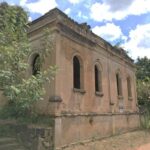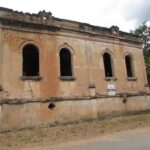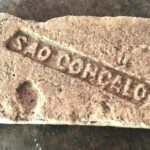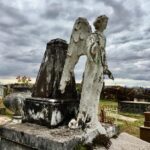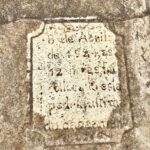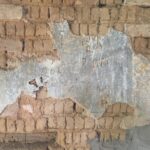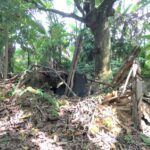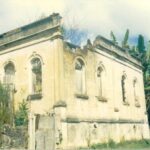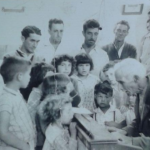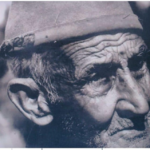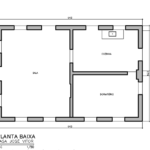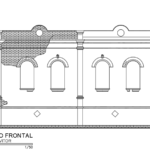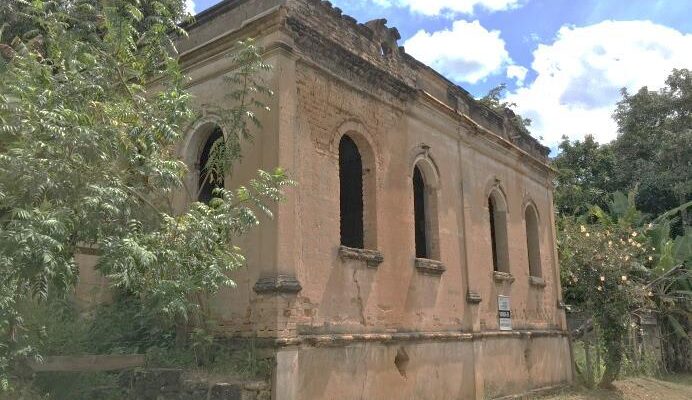
José Vítor’s house
Eclectic mansion of artistic value, in a state of abandonment, with walls currently propped up. Along with the fountain made by the same author, it makes up the architectural and artistic complex on Dr. Sena street, with works by the artist José Vitor.
It deserves a heritage protection and revitalization program.
It adopts an eclectic style, built in line with the street, set on a large plot of land, with an old orchard and, therefore, with trees such as mango trees and large centenary avocado trees. It is a house with a high basement, built in ceramic bricks, with floors in beaten earth and planking over the basement area. It has a rectangular layout, with a plan of only three rooms. The main façade has four window openings, two on each panel, delimited by simulacra of pilasters, with the baldrame panel coated with smooth mortar. The basement glasses have a rhombus finish. The frieze between the basement and the upper floor presents a careful construction system with cantilevered and then coated bricks. The baldrame on the left side reveals the dry stone building system. All external spans have full arched lintels. The roof is topped off at the front by a plinth with a profile in two circles. Access is via doors on the sides and one at the back. It has a projected area of approximately 59m².
Narrativa
“Life and Work of José Vitor Gomes”
(text by Alenice Baeta, Cristina Cairo e Marco Antônio de Souza)
José Vitor Gomes, born in São Gonçalo do Bação, was born in 1894, at the time belonging to the territory of Ouro Preto (until 1922), today, part of the municipality of Itabirito, MG, having died in 1969. It has been 75 years of great creativity, art and dedication to São Gonçalo do Bação and its people.
“(…) he was a genius who dedicated himself to activities, those of a mason, sculptor, painter, musician, writer, inventor, among others. Although there are reports of his low level of education, José Vitor attracted several personalities and politicians interested in observing and learning from his genius” (BAIÃO, 2022).
According to the testimony of Mrs. Divina do Espírito Santo, 94 years old, from Solar Moura Lima, resident of São Gonçalo do Bação: “José Vitor was a very intelligent, discreet man with a good heart. He was a musician and artist. He played in the band, sang and taught music. Father Antônio Cândido created the band and maintained it. The musical instruments belonged to the band, and José Vitor played some of them, such as: organ, harmonica, trombone and saxophone. He was a short man with little hair. Very religious, he used to sleep on a bed consisting of a wooden board with a thin blanket.” Mrs. Divina’s father went to visit José Vitor at his home and was impressed by his simplicity and religious dedication. He was very Catholic, possibly wanting to purify himself by sleeping on the board alone He also designed sophisticated wooden pieces. The clock, inaugurated in 1931, became famous, composed even of nails and recycled material, such as tin boxes and forks, assembled in a very meticulous way to trigger the clappers of the bells at determined times in the tower of the Church of São Gonçalo Bação. (BAIÃO, 2022)
His home is a magnificent example of eclectic construction and style. Their are the different fountains made of bricks, stones and mortar scattered throughout the historic center of Bação on the occasion of the works of the mayor of Ouro Preto, Dr. Joaquim Cândido de Costa Sena, aiming at capturing and distributing water in São Gonçalo do Bação, in 1920. In front of his house, there is even an important example that is part of the set of fountains that he designed. The other fountains that also resisted time and vandalism are the following: two on the old Arraial street or Areal, one on Tombadouro street, one on the old Volta da Lagoa, and another one on Cruzeiro streets. The set of fountains needs an urgent revitalization and heritage and artistic enhancement program.
Mr. Jaber Damasceno, 79 years old, neighbor of José Vitor’s beautiful house and a great connoisseur of his work, says that the artist-builder had, at the time, a pottery where he produced the bricks used in his works. He also used to leave inscriptions on the bricks in order to register and identify the constructive achievements. There is a brick with the date 1920, associated with the occasion of the work on the fountains. The last stone laid in the reform of the Church of São Gonçalo do Bação, was inscribed with the words of José Vitor indicating the day and year of its completion, April 8, 1924. In the bricks, he asks for protection from everyone who worked on the matrix work – peculiar relics of his work and attributes. He would also be the author, in the parish church, according to the record of the Livro do Tombo referring to this work in the Church of São Gonçalo do Bação, of two stone sinks, made in only 3 days with a mallet and a pointer, without mould. It also includes, among the other slab laying activities, that the inscriptions in front of the churchyard are authored, on the left side, “Viva Jesus” and on the right side, “Ave Maria”.
He was an inventor and designer. There was a gap in the façade of José Vitor’s house that allowed the ray of light to reach a mirror in the inner portion of a room that woke up José Vitor. A sunlight clock. Among his various inventions, he would have built a kind of “bicycle with wings”, whose experimental flight would have been strictly prohibited by the then Father Bernardo, who made him give up this bolder and riskier project.
It is possible to notice artistic and stylistic elements of José Vitor in remaining tombs from the 1920s and 1930s in the cemetery of Capela Nossa Senhora do Rosário. In one of them, there is an angel that seems to be similar to the two sculptures, also of angels that were seated in the upper and external part of his house when he was alive, but that disappeared.
“José Vitor Gomes died in 1969 and the mayor of Itabirito at the time, José Bastos Bittencourt, paid him a just tribute by naming the school in Teixeiras, located close to São Gonçalo do Bação, José Vitor Gomes Municipal School”. (BAIÃO, 1922)
Notes
-This set of inventories was prepared exclusively for the purpose of registering the cultural assets indicated by the community of São Gonçalo do Bação to meet the signaling, digital registration and enhancement program for Alleys, Fountains and Historic Attractions Circuits; - The contents of these inventories, if used in reports, other types of inventories and/or publications, must be duly cited, following ABNT rules; - The authorship of the photos and the origin of the iconographic collection (either personal or family collection) must be mentioned.
Information sponsors
Artefactto Consultoria - Alenice Baeta, Cristina Cairo, Hudson Faria e Pedro Loredo

